|

YEAR IN REVIEW
World stock markets climbed steadily throughout fiscal year 2003-04. The Canadian market, measured by the S&P/TSX Composite Index rose by 37.7%. The Canadian economy continued to generate new jobs. The housing market was particularly strong, setting new records in 2003 due in large part to low interest rates and job growth.
Throughout the year, the value of the US dollar weakened against the Canadian dollar. At year-end, $1 US purchased $1.31 Canadian compared to $1.47 Canadian at the end of the previous year. As a result, the appreciation in value of US equity investments was partially reduced when translated into Canadian dollars. Over the year, the US market measured by the S&P 500 Index grew by 35.1% in US dollars and 20.5% in Canadian dollars. The US economy accelerated throughout the year. The US service sector grew while US factories expanded at a healthy pace. Worker productivity also rose, however employment lagged.
The Non-North American market measured by the MSCI EAFE Index increased by a healthy 40.5%. The increase in the Non-North American market over the year was fueled primarily from a stronger US economy.
The following table summarizes the Fund's overall investment returns for each quarter of fiscal year 2003-04.


FUND VALUE
Over the year, the fair value of the Fund rose by $2.45 billion of which $1.13 billion was transferred or payable to the General Revenue Fund resulting in a net increase in the Fund's fair value of $1.32 billion. At March 31, 2004, the fair value of the Heritage Fund stood at $12.4 billion up from $11.1 billion at the beginning of the year.

INVESTMENT INCOME
The Fund recorded net income of $1,133 million during fiscal year 2003-04. Interest, dividends, real estate income and security lending income for the year totaled $421 million, net of administrative expenses. Net realized capital gains from sale of securities and gains arising from derivative transactions totaled $712 million for the year.

INVESTMENT VALUATION
Investments and investment income are recorded on the financial statements of the Heritage Fund at cost in accordance with government accounting policies. The fair value of the Fund and its investments are provided for information purposes. Management uses fair value to assess the investment performance of the fund against market-based benchmarks.
The Fund's policy is to write down the cost of those securities where the decline in value below cost is not considered temporary. On a quarterly basis, management reviews the Fund's investment portfolio to identify those securities where the fair value has declined significantly below cost. The Fund's net income includes writedowns totaling $2.6 million.
CHANGE IN
NET ASSETS
The Heritage Fund accounts for its investments on a cost basis of accounting. Investment income on a cost basis excludes unrealized gains and losses. Investment income on a fair value basis includes unrealized gains and losses. Investment income on a fair value basis for fiscal year 2003-04 was $2.454 billion.

INVESTMENT ASSET MIX
The investment strategy is to invest in a diversified portfolio to optimize long-term returns at an acceptable level of risk. The policy asset allocation is reported in the Fund's 2003-06 business plan as follows:
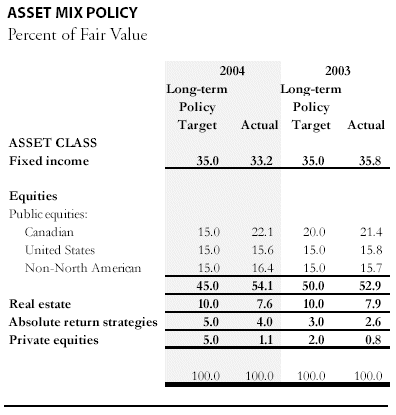
For the 2003-04 fiscal year, the long term policy asset mix for fixed income securities remains the same as the previous year at 35.0%. The policy mix for public equity investments decreases from 50.0% to 45.0% due to a reduction in Canadian public equity investments by 5.0%. The reduction in Canadian public equities is offset by an increase in absolute return strategy investments and private equities. Absolute return strategy investments increase from 3.0% to 5.0% of total portfolio investments while private equities increase from 2.0% to 5.0%. Real estate investments are expected to remain unchanged at 10.0% of total portfolio investments.
The actual investment mix changed over the past year. Fixed income securities declined from 35.8% to 33.2%. Public equity investments increased from 52.9% to 54.1% largely due to the increase in market value of public equity investments relative to other investments. Real estate investments decreased from 7.9% to 7.6% of the Fund's total investment portfolio. Private equity investments increased slightly from 0.8% to 1.1%. Absolute return strategies increased from 2.6% to 4.0% of the Fund's investment portfolio.
TRANSFERS TO THE GENERAL REVENUE FUND
Realized investment income earned by the Fund is not reinvested in the Fund. Instead, all of the net income is transferred to the Province's main operating fund, the General Revenue Fund (GRF), and is used for Albertans' priorities like health care, education, roads, tax reductions and debt repayment. Changes in unrealized gains and losses are not included in amounts transferred to the GRF.
The Fund's net income for the year ended March 31, 2004 amounted to $1,133 million, of which $981 million was transferred and $152 million remains payable to the GRF.
The Government of Alberta financial statements are prepared on a consolidated basis, which eliminates the income the Heritage Fund earns from Alberta provincial corporation securities totaling $17 million for the year ending March 31, 2004. On a consolidated basis Heritage Fund net income was $1,116 million.

HERITAGE FUND RATE OF RETURN
The Heritage Fund posted an overall rate of return of 22.5% this year, 80 basis points better than the Fund's policy benchmark return of 21.7%. The Fund earned positive returns from all asset classes.
The performance of the Heritage Fund is measured over the long term. Over the past four-year period, the fund generated a nominal annualized return of 3.2%. The Heritage Fund is expected to generate a nominal annualized rate of return of 7.4% over four years, which includes a real rate of return of 5.0% plus inflation of 2.4%.

The performance of the Heritage Fund investments is measured against various market-based indices. Value added by investment management is accomplished through asset mix decisions and security selection. The following sections describe the performance of the Fund's major asset classes in relation to their benchmarks.
FIXED INCOME INVESTMENTS
The Canadian bond market performed well this year. The Scotia Capital (SC) Universe Bond Index measures the performance of marketable Canadian bonds with terms to maturity of more than one year. Over the past year, the SC Universe Bond Index increased by 10.8% while the short term SC 91-Day T-Bill Index increased by 3.0%.
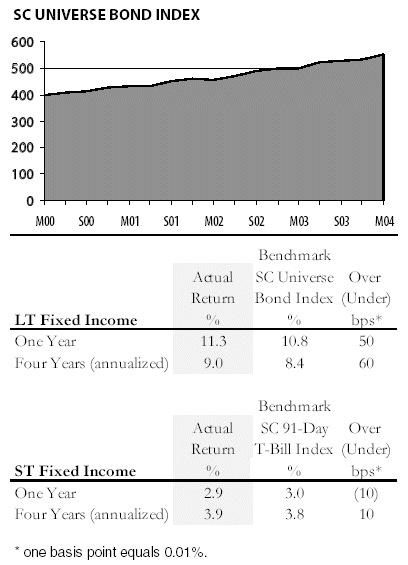
The Fund's actual rate of return over the year from long-term Canadian securities was 11.3%, 50 basis points better than the benchmark SC Universe Bond Index. Over four years, the return from long-term securities was 9.0% or 60 basis points better than the benchmark of 8.4%. The out-performance was primarily due to a higher weight in corporate bonds and duration management. The Fund's return from short-term securities was 2.9% and 3.9% over one year and four years respectively. The Heritage Fund's fixed income portfolio is internally managed through various pools and through direct holdings.
Over the year, investments in bonds, notes, short-term paper, provincial corporation debentures and loans declined from 35.8% to 33.2% of total investments. Fixed income securities now total $4.2 billion, up from $4.0 billion the previous year.
The Fund's Canadian fixed income portfolio is comprised of diversified holdings in corporate, federal, provincial and municipal bonds, notes and short-term paper.
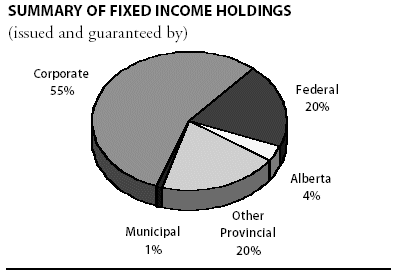
CANADIAN EQUITY INVESTMENTS
The Canadian stock market made substantial gains this year led by the information technology sector, which increased by 112% over the year. The Toronto Stock Exchange S&P/TSX Composite Index, which measures the performance of Canada's top companies in ten industrial sectors, increased by 37.7% for the year ending March 31, 2004.
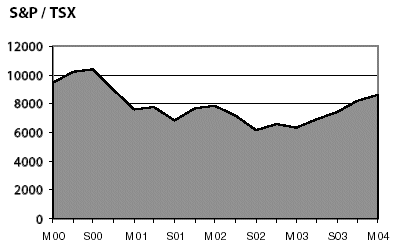

The Heritage Fund's Canadian equity portfolio is held in various investment pools, which are managed by internal and external managers. Over the year the Fund's actual return from Canadian equities rose by 36.6%, 110 basis points below the benchmark S&P/TSX Composite Index of 37.7%. Lower returns from the Canadian large cap sector and an under-weight position in technology stocks contributed to the under-performance. Over four years, the Fund's return from Canadian equities was negative 0.1% compared to the benchmark return of negative 0.8%.
At March 31, 2004, investments in Canadian public equities totaled 22.1% or $2.8 billion of the Heritage Fund investment portfolio compared to 21.4% or $2.4 billion one year earlier.

UNITED STATES EQUITY INVESTMENTS
The United States equity market closed out the fiscal year posting substantial gains. The Standard & Poor's 500 Index, S&P 500, which measures the performance of the top 500 American companies, increased by 35.1% in US dollars and 20.5% in Canadian dollars. All ten industry sectors posted healthy gains.

The Fund's actual rate of return over the year from US equities was 22.0% in Canadian dollars or 150 basis points greater than the S&P 500 Index. Strong performance from the Fund's US small cap stock portfolio and currency hedges contributed to the out-performance. Over four years, the Fund's US equity portfolio returned a negative 7.4%, 50 basis points better than the benchmark S&P 500 Index.
At March 31, 2004, investments in US equities totaled 15.6% or $2.0 billion of the Heritage Fund investment portfolio compared to 15.8% or $1.7 billion a year earlier.

NON-NORTH
AMERICAN EQUITY INVESTMENTS
The Non-North American equity market recorded strong gains this year. The Morgan Stanley Capital International Index for Europe, Australasia, and the Far East, MSCI EAFE Index, measures the performance of approximately 1000 companies on 21 stock exchanges around the world. The index rose by a substantial 40.5% over the year, in Canadian Dollars.

The Fund's actual return from Non-North American equities rose by 40.9% or 40 basis points better than the MSCI EAFE Index. Over four years the Fund's Non-North American equity portfolio returned a negative 7.6%, 40 basis points less than the benchmark MSCI EAFE Index.
The Fund's Non-North American equity portfolio is invested through out the world.
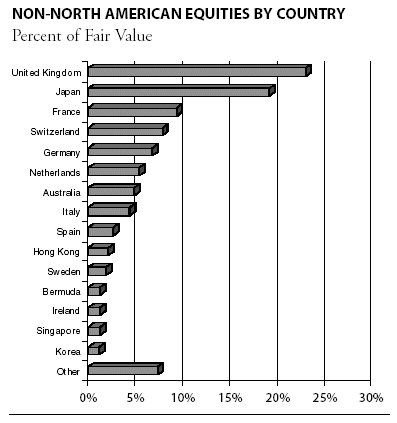
At March 31, 2004, investments in Non-North American equities totaled 16.4% or $2.1 billion of the Heritage Fund investment portfolio compared to 15.7% or $1.7 billion a year earlier.
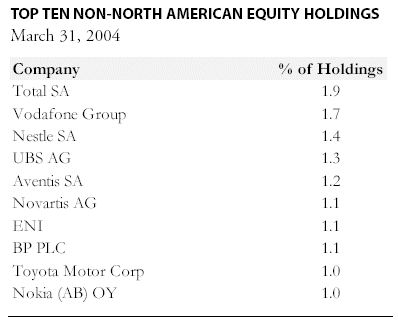
REAL ESTATE INVESTMENTS
The Fund's real estate investments are held in the internally managed Private Real Estate Pool. Real estate investments earned 7.5% over the year and 8.6% over four years. The outperformance over one year was due to strong returns from the portfolio’s retail assets.

Nearly half of the real estate portfolio is invested in retail, half in office and a small portion in industrial and multi-family residential. Approximately 74% of the real estate holdings are located in Ontario, 24% in Alberta and 2% in British Columbia.
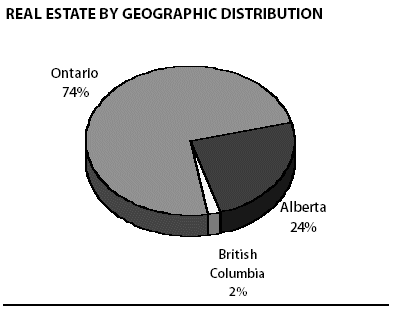
At March 31, 2004, investments in real estate totalled 7.6% or $950 million of the Heritage Fund investment portfolio compared to 7.9% or $870 million one year earlier.
ABSOLUTE RETURN
STRATEGIES
Absolute return strategy investments encompass a wide variety of investments with the objective of realizing positive returns regardless of the overall market direction. A common feature of many of these strategies is buying undervalued securities and selling short overvalued securities. Over the year absolute return strategies generated a return of 10.7%, 400 basis points better than the benchmark Consumer Price Index (CPI) plus 6.0%. The out-performance of absolute return strategy managers over the year was protected by a currency hedge.

At March 31, 2004, investments in absolute return strategies totaled 4.0% or $507 million of total Fund investments compared to 2.6% or $283 million at March 31, 2003.
PRIVATE EQUITY
AND PRIVATE INCOME INVESTMENTS
At March 31, 2004, the private equity and private income portfolio comprised a small portion of the Fund's overall investment portfolio at 1.1% or $136 million compared to 0.8% or $90 million one year earlier. During the year, the private equity and income portfolio returned 4.6%, 410 basis points below the benchmark Consumer Price Index plus 8%. Private equity and income investments had lower returns due to higher initial management fees and start-up costs.


Administrative
Expenses
Administrative expenses include investment management, cash management, security system costs, valuation and fund accounting costs, security custody and transaction costs, financial reporting and investment policy costs and other expenses. External management and custodial fees are deducted directly from the income of externally managed investment pools. Internal administrative expenses are deducted from the internally managed pooled funds and also directly from the Fund.
The Fund's total administrative expenses for the year ended March 31, 2004, including amounts deducted from the investment income of the pooled funds, amounted to $17.9 million or 0.145% of the Funds net assets at fair value compared to $15.9 million or 0.144% of net assets for the same period last year. Expenses as a percentage of net assets at fair value remained approximately the same over the year.
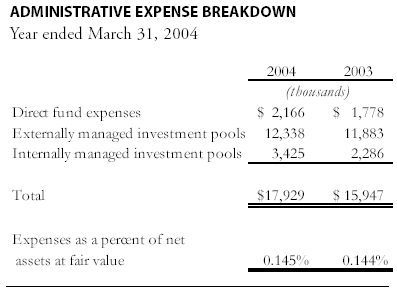
Over the past year, expenses of direct and internally managed investment pools increased by $1.527 million over the same period last year. The net increase in expense for the internally managed pools was due to additional staffing requirements, system improvements and transfer of costs associated with the transfer of US passively managed investments from external managers to internal managers.
Expenses from externally managed investment pools increased by $455 thousand over the same period. The net increase in expenses from externally managed pools is due to the Absolute Return Strategy Pool.



| 
























